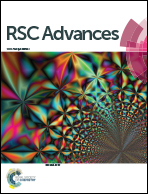Shedding light on the soft and efficient free radical induced reduction of graphene oxide: hidden mechanisms and energetics†
Abstract
Reduction of graphene oxide (GO) in aqueous dispersions by strongly reducing free radicals has recently been identified to be a very powerful approach, because functional groups are removed softly but efficiently, and non-volatile impurities as well as defects are largely avoided. However, the reaction mechanisms remained somewhat speculative. Recently we showed that GO can be efficiently reduced in water by indirect photoreduction mediated by (CH3)2˙C(OH) radicals generated via the reaction of triplet acetone with isopropanol. Those radicals efficiently defunctionalize oxo-groups of GO forming the carbon lattice without generating additional defects. In this comprehensive study we shed more light on the reaction mechanism of reduction of GO by H˙, CO2˙−, (CH3)2˙C(OH) and CH3C˙H(OH) by combining pulsed radiolysis and determine its overall energetics via quantum-chemical calculations. In time-dependent experiments mechanistic insights have been obtained and unknown intermediates have been discovered. Moreover, different reduction mechanisms, such as radical addition, electron-transfer, concerted water elimination and HCO3− elimination are identified. Here we show that all mechanisms lead to sp2-carbon formation and therefore high quality graphene by reductive defunctionalization.


 Please wait while we load your content...
Please wait while we load your content...